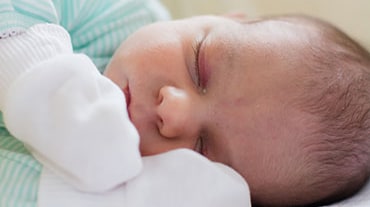Key points
- Newborns can develop pink eye, called natal conjunctivitis, caused by infection, irritation, or a blocked tear duct.
- Pink eye can cause serious health problems for newborns if it's not treated.
- Newborns should be seen by a doctor right away if they have pink eye symptoms.

Signs and symptoms
Newborns with pink eye develop drainage from the eyes within a few days to several weeks after birth. Their eyelids become puffy, red, and tender.
What causes it
The cause of newborn pink eye is often difficult to determine because symptoms are often very similar for each cause.
Pink eye in a newborn may be caused by:
- A blocked tear duct
- Irritation produced by the topical antimicrobials given at birth
- An infection passed from the mother to baby during childbirth
Even mothers without symptoms at the time of delivery can carry and pass bacteria or viruses to babies during birth.
Types
The most common types of newborn pink eye include:
Chlamydial conjunctivitis
- Cause: A mother with untreated chlamydia can pass the bacteria to the baby during childbirth
- Symptoms: Redness of the eyes, swelling of the eyelids, and discharge of pus. Some newborns with chlamydial conjunctivitis can have the infection in other parts of their bodies. The bacteria can infect the lungs and nasopharynx (where the back of the nose connects to the mouth).
- Begins: Symptoms are likely to appear 5 to 12 days after birth. Symptoms can develop earlier if the amniotic sac is ruptured during delivery.
Gonococcal conjunctivitis
- Cause: A mother with untreated gonorrhea can pass the bacteria to the baby during childbirth.
- Symptoms: Red eyes, thick pus in the eyes, and swelling of the eyelids. It can also progress to serious infections of the bloodstream (bacteremia) and lining of the brain and spinal cord (meningitis) in newborns.
- Begins: First 2-5 days of life.
Chemical conjunctivitis
- Cause: When eye drops are given to newborns to help prevent a bacterial infection, the newborn’s eye may become irritated.
- Symptoms: Mildly red eye and some swelling of the eyelids. Symptoms are likely to last for only 24 to 36 hours.
Other neonatal conjunctivitis
- Cause: Viruses that cause genital or oral herpes, and bacteria other than chlamydia and gonorrhea, can cause pink eye and severe eye damage in newborns. This includes bacteria that normally live in a mother's vagina and are not sexually transmitted. They may pass such viruses to the baby during childbirth. However, herpes conjunctivitis is less common than conjunctivitis caused by gonorrhea and chlamydia.
- Symptoms: Red eye and swollen eyelids with some pus.
How to prevent it
When to consult your doctor
To prevent pink eye, most states have laws requiring providers to put drops or ointment in a newborn’s eyes. This typically happens within 2 to 3 hours of birth. In the past, hospitals used silver nitrate. Now, hospitals mostly use antibiotic eye drops, typically erythromycin.
Treatment and recovery
If baby has an infection
Doctors may treat neonatal conjunctivitis caused by a bacterial infection with antibiotics. It will depend on the severity of the infection and the bacteria that caused it.
Rinsing the newborn's infected eye with a saline solution will remove any debris that may develop in response to the infection.
How antibiotics are applied
- As an eye drop or ointment in the eye (topical)
- By mouth (orally)
- Through a vein (intravenous or IV)
- As a shot (intramuscular)
- Doctors may combine topical antibiotics with one of the other methods
If baby has a blocked tear duct
If a blocked tear duct causes pink eye, a gentle, warm massage between the eye and nasal area may help. If the blocked tear duct does not clear by 1 year of age, the newborn may require surgery.
How to treat by type of pink eye
Chlamydial conjunctivitis
Doctors usually use oral antibiotics to treat inclusion conjunctivitis.
Gonococcal conjunctivitis
Doctors give IV or intramuscular antibiotics to treat gonococcal conjunctivitis. If untreated, the newborn could develop corneal ulcerations (open sores in the cornea) and blindness.
Chemical conjunctivitis
Since this type of pink eye is caused by chemical irritation (like from eye drops), treatment is usually not required. The newborn will usually get better in 24 to 36 hours.
Other bacterial and viral conjunctivitis
Doctors usually give antibiotic drops or ointments to treat conjunctivitis caused by other bacteria. For both bacterial and viral conjunctivitis, a warm compress to the eye may relieve swelling and irritation. Be sure to wash hands before and after touching the infected eyes.
